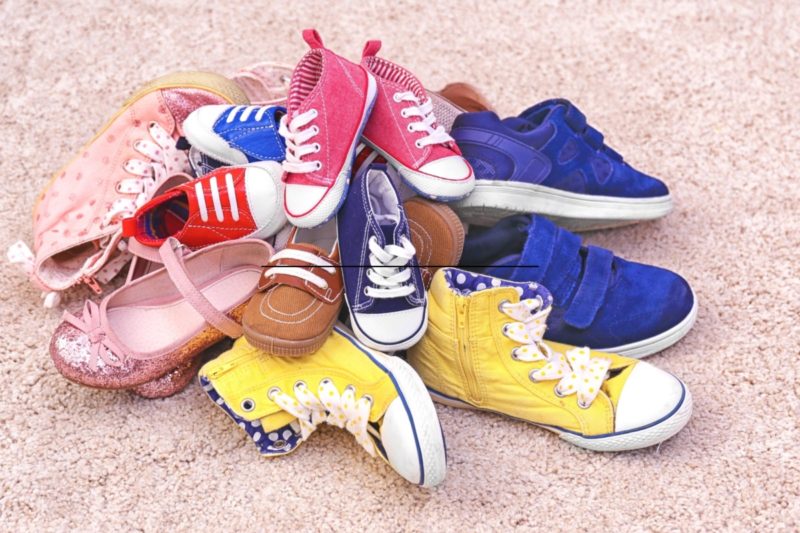Kids shoes must fit just right, but picking the right size might be confusing due to different kids shoe size charts. There’s a different size chart for toddlers in the US and different size charts in the UK or Europe. On top of that, even if you measure your child’s feet it might not always help you because US uses inches while the rest of the world uses centimeters.
I’ve moved around with my kids a lot, so we got to experience the struggle first-hand. Plus, if you want to purchase some shoes abroad this shoe size chart for children might help you.
How to Measure Kids Feet?
Put your child’s foot on a blank piece of paper and trace around it, then measure with a ruler or measuring tape. Some brands (for example Ikiki or Stride Ride) even let you print their own size chart to make sure the shoes fit correctly.
Measure the foot also with a thicker sock on, to make sure you can comfortably put on the shoe. There should be about a half inch between the end of the longest, fully extended toe and the end of the shoe.
Remember, always measure both feet. It’s not uncommon for one foot to be smaller than the other. Unless you’re given a choice if to get two different sizes, buy the bigger size if one foot is bigger.
Baby Shoe Size Chart (0 to 12 Months)
Baby shoe sizes explained
For babies, there isn’t really universal sizing. Some brands label the shoes by age and tend to use wider ranges for babies. (e.g., 6-12 months or 12-18 months).
Baby shoes for non-walkers are mostly decorative and not useful at all. Once your baby is over 6 months old and it’s cold outside you might consider baby booties instead of shoes with a hard sole.
| US baby shoe size | Baby’s age | Euro | UK | Inches | CM |
| 0.5 | newborn | 16 | 0 | 3.25 inches | 8.3 centimeters |
| 1 | 0 – 3 months | 16 | 0.5 | 3.5 inches | 8.9 centimeters |
| 1.5 | 17 | 1 | 3.625 inches | 9.2 centimeters | |
| 2 | 3 – 6 months | 17 | 1 | 3.75 inches | 9.5 centimeters |
| 2.5 | 18 | 1.5 | 4 inches | 10.2 centimeters | |
| 3 | 6 – 12 months | 18 | 2 | 4.125 inches | 10.5 centimeters |
| 3.5 | 19 | 2.5 | 4.25 inches | 10.8 centimeters | |
| 4 | 19 | 3 | 4.5 inches | 11.4 centimeters |
Toddler Shoe Size Chart (1 to 4 Years)
| U.S. | Euro | UK | Inches | CM |
| 4.5 | 20 | 3.5 | 3.625 inches | 11.7 centimeters |
| 5 | 20 | 4 | 4.75 inches | 12.1 centimeters |
| 5.5 | 21 | 4.5 | 5 inches | 12.7 centimeters |
| 6 | 22 | 5 | 5.125 inches | 13 centimeters |
| 6.5 | 22 | 5.5 | 5.25 inches | 13.3 centimeters |
| 7 | 23 | 6 | 5.5 inches | 14 centimeters |
| 7.5 | 23 | 6.5 | 5.625 inches | 14.3 centimeters |
| 8 | 24 | 7 | 5.75 inches | 14.6 centimeters |
| 8.5 | 25 | 7.5 | 6 inches | 15.2 centimeters |
| 9 | 25 | 8 | 6.125 inches | 15.6 centimeters |
| 9.5 | 26 | 8.5 | 6.25 inches | 15.9 centimeters |
| 10.5 | 27 | 9 | 6.5 inches | 16.5 centimeters |
| 11 | 28 | 10 | 6.75 inches | 17.1 centimeters |
| 11.5 | 29 | 10.5 | 7 inches | 17.8 centimeters |
Kids Shoe Size Chart (4 to 12 Years)
Kids shoe size chart in the US is super confusing, especially once your child is about 7 years old. In Europe or any other country, the numbers indicating the bigger size just keep increasing, but in the US the shoe goes back to size 1.
| U.S. | Euro | UK | Inches | CM |
| 12 | 30 | 11 | 7 inches | 18.1 centimeters |
| 12.5 | 30 | 11.5 | 7.25 inches | 18.4 centimeters |
| 13 | 31 | 12 | 7.5 inches | 19.1 centimeters |
| 13.5 | 31 | 12.5 | 7.625 inches | 19.4 centimeters |
| 1 | 32 | 13 | 7.75 inches | 19.7 centimeters |
| 1.5 | 33 | 14 | 8 inches | 20.3 centimeters |
| 2 | 33 | 1 | 8.125 inches | 20.6 centimeters |
| 2.5 | 34 | 1.5 | 8.25 inches | 21 centimeters |
| 3 | 34 | 2 | 8.5 inches | 21.6 centimeters |
| 3.5 | 35 | 2.5 | 8.625 inches | 21.9 centimeters |
| 4 | 36 | 3 | 8.75 inches | 22.2 centimeters |
| 4.5 | 36 | 3.5 | 9 inches | 22.9 centimeters |
| 5 | 37 | 4 | 9.125 inches | 23.2 centimeters |
| 5.5 | 37 | 4.5 | 9.25 inches | 23.5 centimeters |
| 6 | 38 | 5 | 9.5 inches | 24.1 centimeters |
| 6.5 | 38 | 5.5 | 9.625 inches | 24.4 centimeters |
| 7 | 39 | 6 | 9.75 inches | 24.8 centimeters |






Leave a reply